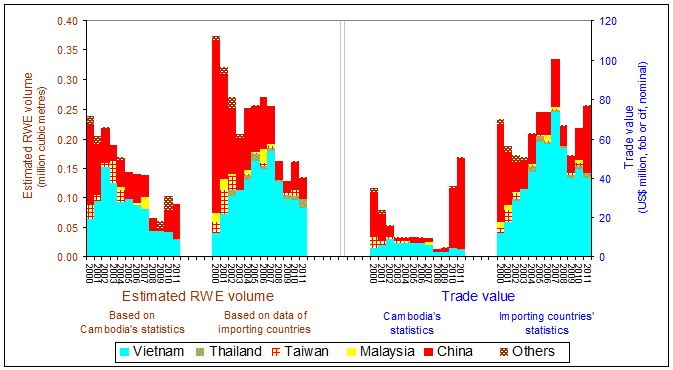|
|
||
|
Cambodia Sawn wood comprises the great majority of the timber which Cambodia exports. During the early years of last decade, China's imports of veneer and plywood were substantial.{Footnote 1} Chart 1 - Trade in timber from Cambodia{Footnote
2} Chart 1 above compares the export statistics which Cambodia reports with the import statistics reported by the countries to which those exports are destined. Given that they are neighbours, there is a remarkable difference between the annual trade values reported by Cambodia and Vietnam for the same trade flows. Much larger quantities of timber were exported from Cambodia (mainly to Thailand) during the 1990s under controversial circumstances.[*] The export of logs has been banned since 1996.[penultimate ¶, p33] Logging in permanent forest is prohibited.[sixth ¶, p37] A moratorium during 2002 was widely ignored.[*] Much forest is now designated for conversion to commercial agriculture particularly rubber plantations. This has a severe impact on local communities, whose livelihoods are largely dependent on forests.[*] These "Economic Land Concessions" are currently the primary driver of deforestation in Cambodia and also the main supplier of logs for milling and export. Several of these are considered inappropriate[*] and are likely to be cancelled. [slide 20] One such concessionaire claims to have underestimated how efforts by Cambodia to minimise the supply of Illegal Timber would affect its business strategy. [final ¶, p1] There have recently been protests across the country concerning the allocation of important forest areas for conversion.[*] Military and other officials have supported logging in supposedly protected forest.[*] The media continue to report illegal logging in forest along Cambodia's border - these tend to involve the smuggling of small volumes of high value timber - including by armed groups[*] some supposedly from Thailand.{Footnote 3} Although the authorities have made greater effort to minimise illegal logging since about 2009,[*] their success is not been universal.[*] It would seem that Cambodia's forests continue to be managed for the benefit of Cambodian elites, the military and the family of the long-standing Prime Minister in particular. Their involvement over many years is well documented.[*] Donors have turned a blind eye and the World Bank has been obliged to admit faults in its lending.[*] Political interference persists.[clause 5; also second •, p2] Vietnam imports most of the timber which is exported from Cambodia. A group owned by the government of Vietnam has a record of procuring illegal timber from Cambodia.[Vinafor, p15] Much of the timber which Cambodia exports is "rosewood" typically Dalbergia cochinchinensis - a species whose logging is prohibited in Cambodia.[p2] Efforts by Thailand to list the species under CITES are being resisted by Cambodia and Laos.[p1] In Cambodia, trade in this species is characterised frequently by violence - particularly against those seeking to expose illegality.[*]
Footnote 1: The great majority of Cambodia's export revenue is attributable to clothing (importing countries reported roughly US$ four billion of clothing imports during each of the last four years). Footnote 2: Source (exports by Cambodia): based on UN Comtrade. Source (imports from Cambodia): various official sources - see footnote 1 (Vietnam has not yet published its 2011 trade statistics) Note: roundwood equivalent ("RWE") volume for Vietnam's imports has been estimated notionally from import value. Cambodia's bilateral trade statistics might be less reliable than those of some of its partners. Footnote 3: This current Thai activity differs from that which took place during the 1990s and which Global Witness has extensively documented. |
||
|
|
||

